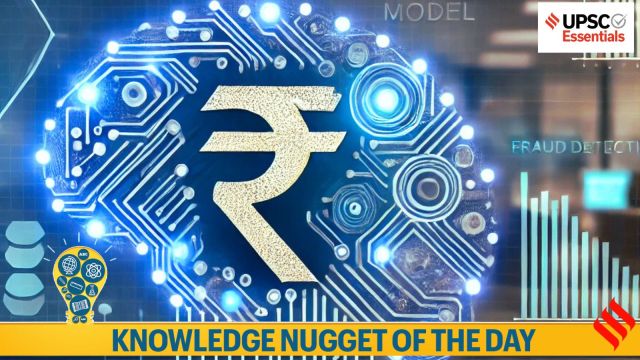Take a look at the essential events, concepts, terms, quotes, or phenomena every day and brush up your knowledge. Here’s your knowledge nugget for today.
Knowledge Nugget: MuleHunter.AI
Subject: Technology and Economy
(Relevance: Artificial intelligence (AI) and its applications across various fields have become essential in our lives. With the rising incidents of digital fraud, it is important to understand how AI-powered models can help address this issue. Additionally, the UPSC has previously asked questions related to AI and its applications. Therefore, knowing about the MuleHunter.AI is important for your UPSC preparation.)

Why in news?

On Friday (6th December), the Reserve Bank of India (RBI) announced that it has created an AI-powered model called
MuleHunter.AI, which could reduce digital fraud by helping banks deal with the increasing problem of “mule” bank accounts. It has been developed by the Reserve Bank Innovation Hub.
Story continues below this ad
Key Takeaways :
1. MuleHunter.AI enables the detection of mule bank accounts in an efficient manner. The RBI release said that a pilot with two large public sector banks had yielded encouraging results and asked banks to collaborate with RBIH to further develop the MuleHunter.AI model “to deal with the issue of mule bank accounts being used for committing financial frauds.”
2. The government is also putting efforts into cracking down on mule accounts. On Friday, the Department of Financial Services Secretary had a meeting with officials from the RBI, the Indian Cybercrime Coordination Centre (I4C), which is affiliated with the Union Home Ministry, the National Bank for Agriculture and Rural Development, and public- and private-sector banks to discuss the growing challenge of digital financial fraud, especially mule accounts.
3. At Friday’s meeting, banks were urged to adopt best practices, leverage cutting-edge tools, and foster inter-bank collaboration to address mule accounts effectively. They were also encouraged to explore and implement the RBI’s Mulehunter.AI solution to step up the detection and monitoring of mule accounts.
Mule Bank Account
1. Mule bank accounts are seen as a key element in the majority of online financial frauds in India. Notably, The Indian Express reported last month that the Centre had frozen around 4.5 lakh such bank accounts, which were typically used for laundering proceeds of cyber crime.
Story continues below this ad
2. A mule account is a bank account that is used by criminals for illegal activities, including the laundering of illicit funds. A mule account is typically bought over by the criminals from their original users, individuals who are often from lower income groups, or have low levels of technical literacy.
3. The term “money mule” is used to describe the innocent victims who are used by the criminals to launder stolen or illegal money via their bank accounts. When such incidents are reported, the money mule becomes the target of police investigations, because it is their accounts that are involved, while the actual criminals remain undetectable.
BEYOND THE NUGGET: Artificial Intelligence, Machine Learning and Deep Learning
1. Artificial Intelligence (AI) is the ability of machines, especially computers, to perform tasks that typically require human intelligence. These tasks include things like understanding language, recognising patterns, solving problems, and making decisions.
2. Breakthroughs in computational power and big data accelerated AI’s capabilities in image and speech recognition, natural language processing, and autonomous systems. Today, AI continues to evolve, integrating into various industries, driving innovation, and transforming everyday life.
Story continues below this ad
3. AI can be classified into two types: Artificial Narrow Intelligence (ANI) also known as weak AI and Artificial General Intelligence (AGI) also referred to as strong AI.
4. ANI is designed for specific tasks and excels within a narrow domain. Examples include virtual assistants like Siri, recommendation systems on platforms like Netflix, and image recognition software.
5. AGI aims to replicate human cognitive abilities, enabling it to perform any intellectual task a human can do. AGI would possess general reasoning skills, understand context, and adapt to new situations across various domains. It would be capable of autonomous learning and problem-solving without requiring task-specific programming.
6. Machine Learning (ML) and Deep Learning (DL) are subsets of AI but differ in complexity and capabilities.
Story continues below this ad
7. Machine Learning involves training algorithms to learn from data and make predictions and often requires manual feature extraction.
8. Deep Learning is a subset of ML and uses neural networks with many layers (hence “deep”) to automatically learn features from large datasets. While ML works well with smaller datasets, DL requires vast amounts of data and computational power.
(S0urces: How RBI is leveraging AI to crack down on ‘mule bank accounts’, What is Artificial Intelligence, how is it revolutionising healthcare)
For your queries and suggestions write at roshni.yadav@indianexpress.com
Story continues below this ad
Subscribe to our UPSC newsletter and stay updated with the news cues from the past week.
Stay updated with the latest UPSC articles by joining our Telegram channel – Indian Express UPSC Hub, and follow us on Instagram and X.



































